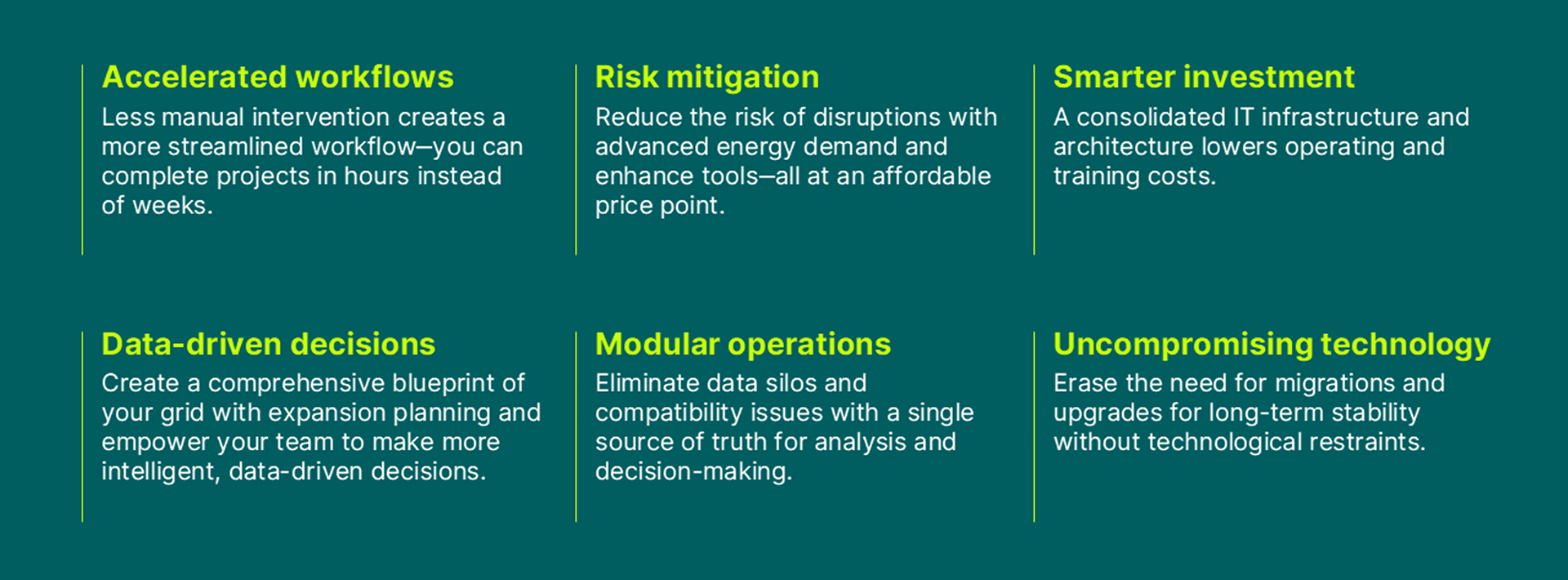Power Flow (formerly PSLF)
Power Flow helps you more accurately describe and simulate the behavior of the grid and connected equipment under stable operating conditions. Additionally, you can identify potential vulnerabilities and help ensure reliable operation. With this function, your team can execute transmission planning, interconnection, and contingency and transfer analyses within the Power Flow function of PlanOS, with no third-party software required. Allowing you to create monitored and contingent element lists, including custom contingencies.
- Contingency analysis: A vital process in power systems engineering that evaluates the impact of potential failures or unexpected events on the power grid. By simulating various hypothetical scenarios, like the sudden loss of a transmission line or generation unit, this analysis helps ensure the stability and reliability of the power system under different conditions. Contingency analysis is natively integrated into the Power Flow function of PlanOS.
- Transfer capability analysis: This crucial process evaluates the highest amount of electrical power that can be transferred over the transmission network from one area to another without violating system limits under steady-state conditions. By assessing the transfer limits, this analysis helps ensure the safe and reliable operation of the power grid.
Resource Adequacy (formerly MARS)
Based on full sequential Monte Carlo simulations, Resource Adequacy enables you to assess whether the system has enough resources to help meet demand. By simulating the grid hour-by-hour, Resource Adequacy gives you a detailed look at how well the system can handle variations in demand, planned maintenance, and unexpected outages.
Resource Adequacy helps you run potential scenarios and power assessments, like NERC PROB-A, to evaluate generation reliability and reduce risks. It also enables you to model renewable energy sources while preserving the correlation to load demand and calculating equivalent load-carrying capacity to improve resource adequacy planning. Like the Power Flow function, Resource Adequacy has built-in contingency and transfer analyses capabilities. Contingency analysis and transfer analysis provide the technical basis for assessing the reliability and adequacy of the power system.
- Contingency analysis: A critical process identifying potential capacity shortfalls from outages that could affect resource adequacy.
- Transfer analysis: Helps to ensure adequate capacity in the transmission system to transfer power as needed, analyzing power flow between major load areas of your system and contingencies.
Production Cost (formerly MAPS)
The economics of your power system play an essential role in the day-to-day operation of your plant. Production Cost modeling from GE Vernova helps you analyze generation systems and transmission operations while helping to maintain costs. The Production Cost modeling function of PlanOS helps you to meet your business needs by simulating chronological load to more accurately model path-dependent quantities like run-time and storage. It can also help you determine transmission bottlenecks that might affect the economic operation of your system, giving you a more complete view of how generation systems and transmission operations interact.
Capacity Expansion (new offering)
The energy industry is evolving fast, making planning more complex than ever. The Capacity Expansion function of GE Vernova’s PlanOS helps forecast capacity additions while considering uncertain variables, allowing you to make wiser, more cost-effective investment decisions.
Aiming to meet global decarbonization** policies more effectively and reliably requires tools capable of forecasting capacity additions. Current challenges in the energy sector and industry create a wide range of possible futures. Capacity Expansion gives you a stochastic approach to planning for this uncertainty. While prioritizing interoperability, Capacity Expansion is engineered to work across the Power Flow, Resource Adequacy, and Production Cost functions within PlanOS.
Why PlanOS?



